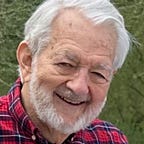ATTENDING THE BIRTH OF THE COMPUTER REVOLUTION
I had a buddy in grade school, his name was Roger and he lived across the street.
Roger’s father and his uncles had started an electronics company in St. Paul, Minnesota just after World War II, though being a high-tech start-up then was something very different from today.
One Saturday morning in October 1955 when we were in sixth grade, Rog called and asked if I wanted to go with him to his dad’s office. We could horse around downtown while Mister worked. Heck yes, I said. So we climbed into the family Olds, where the back seat faced out and to the back.
First, the office was not in a glass tilt-up structure in a suburban R&D office park. There were no such things then. Instead it was in a big old red brick warehouse, surrounded by other brick warehouses, in the part of St Paul that would later be called ‘Old Town.’
We entered the big windowless office, made of concrete blocks with an 18-foot ceiling, on the third floor of the warehouse. All I remember seeing were glass tubes everywhere — big ones, small ones, some as big as your head. If you wanted to sit, you had to move vacuum tubes. If you wanted a writing surface, you had to move the tubes you’d moved once already to sit. They were everywhere.
The father went to work, and Roger and I explored the office, the warehouse, and the neighborhood.
And the biggest thing in the neighborhood was the St. Paul Union Depot, one of the busiest in America then. Much of the natural wealth of the northwest quadrant of the entire United States passed through St Paul / Minneapolis, the Twin Cities:
· grain from the Dakotas went to Minneapolis, to be processed into cereal and flour by General Mills and Pillsbury;
· cattle from Montana and Wyoming were shipped to the slaughterhouses of South St. Paul, the second busiest after Chicago;
· and lumber from Oregon and Washington to build the new suburbs springing up after World War II passed through the Twin Cities. Some was then loaded onto Cargill barges to go south on the Mississippi; some went to the Twin Ports of Duluth and Superior headed east to supply builders in the Northeastern states.
And here, in this small office a New Economy was being born based on information, not grain or livestock or lumber. The idea then must have sounded preposterous. You can’t eat information, and it won’t protect you from the rain. Or so it seemed then.
At noon, we regrouped at the office and spread out our bag lunches that Roger’s mother had made — after moving more glass vacuum tubes.
And Roger’s dad casually said, “Boys, what we’re doing here will change everything. Why, by the time you’re my age you may not even have to work. Everything will be done by machines. Just think about it. You’ll spend your whole day doing what you want — read what you want, travel, play golf or tennis, listen to music anywhere. Welcome to the future. It’s going to be great!”
I told Roger’s dad that really sounded great. Then I asked him why we needed to go to school if we wouldn’t need to work when we grew up.
“Tommy [with exasperation] don’t jump to conclusions. Your generation will have to build the machines that will make that happen. And please do not tell your parents that I said you could drop out of sixth grade because you won’t have to work when you grow up. Please, promise me that, okay?”
Those words over baloney sandwiches in a big old red brick warehouse two blocks from the St. Paul Union Depot on a Saturday morning in October 1955 set a very high expectation for me and would come back to me again and again later in my life.
Indicative of how fast that nascent electronics/computer industry was growing then, even as we ate our sandwiches in St Paul, out in a small farm town south of San Francisco, called Mountain View, a man named William Shockley was starting to make little devices to replace the glass vacuum tubes.
His little gizmos were smaller, more rugged, and quicker to turn on than glass tubes, like Roger’s dad was making. And they were made of silicon, an element that can both conduct and not-conduct an electronic signal, depending on how it is processed. In very short order Shockley’s ‘semi-conductors’ would replace the glass tubes.
And two years later I got my first transistor radio for a birthday present.
And for then, the dream took root in my imagination. A future where we could offload all the drudgery of work (even homework) to smart machines, and just take our time and enjoy a life without stress and strain. That would be some marvel surely.
About twenty-five years later, I left the wife and two-year old son to pack up and sell our home in Minneapolis. And I put all I could into my little yellow VW bug and joined the throng heading over Donner Pass on Labor Day weekend in 1979, to the San Francisco Bay Area. We were not going to be like the gold prospectors a century before. We would be the new alchemists, turning sand into gold.
And what could possibly go wrong with that?
© 2022 Thomas Mahon
